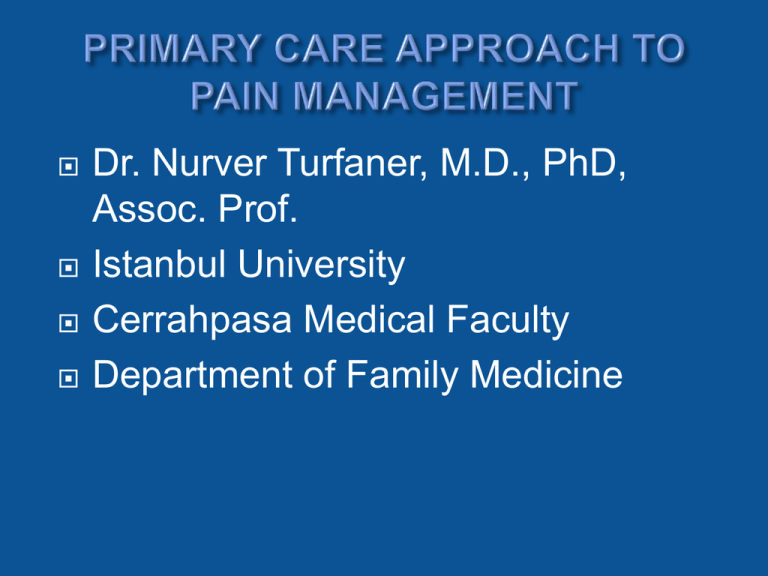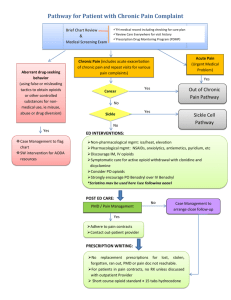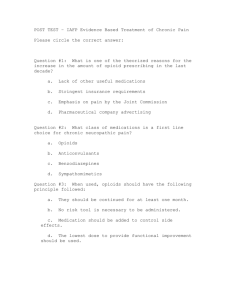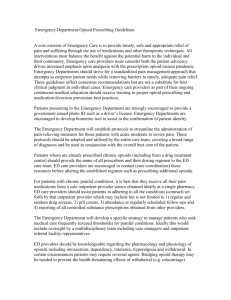DIFFERENCES BETWEEN ACUTE AND CHRONIC PAIN
advertisement

Dr. Nurver Turfaner, M.D., PhD, Assoc. Prof. Istanbul University Cerrahpasa Medical Faculty Department of Family Medicine • • Pain: the 5th vital sign (pulse, blood pressure, temperature, respiration) an unpleasant sensory and emotional experience associated with actual or potential tissue damage or described in terms of such damage • • • • • • Age Anxiety Culture Fear Gender Observational learning (family history of pain/previous experience of pain • • • • • • • • Personality: Introvert: greater sensitivity, fewer complaints Extrovert: High pain tolerance Psychological factors Religion Response of healthcare staff Sleep deprivation Society • • • • • • Clinician influenced Insufficient knowledge Lack of pain training in medical school Lack of pain-assessment skills Rigidity or timidity in prescribing practices Overestimation of risks involved in the therapy • • • • • • • • Patient influenced Reluctance to report pain Reluctance to take opioid drugs Poor adherence to management plan Healthcare system influenced Low priority given to symptom control Unavailability or bureaucracy in opioid analgesic administration Inaccesibility of specialised care To make a working diagnosis define the extent of injury or disease • To determine the type of pain • To establish co-existing medical, emotional and psychological factors influencing pain (soldiers and sportsmen can sustain severe physical trauma without initially feeling pain) • • • • • To determine a pain management strategy on the basis of information obtained To evaluate response to therapy To compare and monitor progress of individual patients To validate effectiveness of new treatments for clinical and research purposes • • • • • • • • First- hand history from the patient Pain description: a verbal picture of pain Primary or secondary complaint Location and radiation Specific site of pain Mode of onset Intensity and severity Character • • • • • • • • • Temporal features Exacerbating and relieving factors Associated symptoms How pain has changed since onset Treatments so far Medical aspects Functional status Psychological assessment Factors relevant to treatment • • Inspection: Attention to symmetry and cutaneous landmarks Skin colour, rashes, scars, abnormal hair growth, pseudomotor dysfunction, oedema, muscular atrophy, hypertrophy or fasciculations, spinal curvatures, limb lengths • • • Palpation: Perform in a systematic and comprehensive manner from the least painful to the most painful area helps differentiate normal tissues and painful region Elicits gross sensory changes: allodynia, dysaesthesia,paraesthesia, hyper/hypoalgesia, hyperpathia, hypoaesthesia and analgesia dolorosa Elicits painful muscle bands or nodules, (tender/trigger points), neuromas in scars, peripheral pulsations and temperature • Percussion: can indicate nerve entrapment or presence of a neuroma (Tinel’s sign). Percussion of bony structures may indicate fracture, dislocation, inflammation, infection • Range of motion: for articulated areas, active and passive range of motion, all movements possible for that particular joint and their effect on pain in degrees • Motor examination: Muscle bulk, tone, isolated muscle power, involuntary movements should be assessed and correlated with myotomal innervations • • • Sensory examination: response to light touch, light pressure, pinprick or cold and vibration Match any sensory changes to dermatomal and peripheral cutaneous nerve maps to assess the anatomical significance Reflexes: tendon reflexes are increased in upper motor neurone lesions and decreased in lower motor neurone lesions and muscular diseases • • • • • • • • • Provocative tests: concordant vs nonconcordant pain Phalen’s sign: carpal-tunnel’s syndrome Patrick/Faber (Flexion ABduction External Rotation): for hip pathologies Sciatic and femoral nerve stretching tests Straight leg raising test Lasegue’s test: differentiate hamstring tightness and spondylolisthesis Crossed SLR Bowstring test Valsalva manoeuvre Investigations • • • • • • • radiological examinations; Plain X-rays MRI fMRI CT SPECT scan Others: thermography, diagnostic nerve blocks, measurement of autonomic variables These investigations are helpful to rule out rather than diagnose the cause of pain Repetition of investigations will have potentially negative effects on the patient’s expectations of management and be an unnecessary expense • • • • The multidimensional nature of pain offers many potential ‘targets’ for measurement. Pain is a subjective, personal experience, the logical and true assessments of a patient’s pain must be the patient’s own report. The self-report is the gold standard of pain measurement. Self report measurement tools: unidimensional (e.g. categorical scales, numerical rating scales (NRS), visual analogue scales (VAS), picture scales or pain drawings Multidimensional: e.g. McGill pain questionnaire • • • • • • • Categorical scales/verbal rating scales Are you in Pain?-yes/no none, mild, moderate,severe, excruciating Pain relief: none, slightly, moderate, good, complete 0,1,2,3,4 Advantages: quick, simple,suitable for the elderly,older children,visually impaired, sensitive to ethnic and gender differences Disadvantages: subject to bias • Visual analogue scales: 10 cm straight line, scoring by measuring the distance in mm from left to right no pain No pain relief worst pain imaginable complete pain relief • • Advantages: quick, simple, avoidance of imprecise, descriptive terms, suitable for children over 5 years, parametric statistical tests can be applied Disadvantages:more demanding, requires greater cognitive skills (concentration,language), may not be easy to measure extremes, can be influenced by medication, sleep disturbance, it measures relief better • • • • • • • • • Classical Pain: three dimensions sensory-discriminative Motivational-affective Cognitive-evaluative Long-form McGill questionnaire Short form of McGill pain questionnaire Brief pain inventory Health-related quality of life measures Hospital anxiety and depression scale • • • • • • Post-operative Pain Assessment of pain in children: Physiological: heart rate, blood pressure, respiratory rate, palmar sweating, transcutaneous oxygen, serum catecholamine, glucagon and cortisol Behavioural: crying, grimacing, irritability Self-report measures: faces scale,VAS,CHEOPS,FLACC(face-legs-activitycry-consolability) Pain in the elderly: be aware of dementia, confusion and cognitive deficit,deafness • • • • Pain assessment is multidimensional including biological, psychological and social elements A thorough history is required along with what the pain means to the patient Patient expectations must be assessed before a management plan is produced Many scoring systems exist for scoring pain and are validated in a variety of clinical and research settings • • • Patient self-reports of pain and direct involvement in assessment is the gold standard. Observational reporting and proxy reporting are less reliable Pain should be considered as the 5th vital sign with documentation showing the intensity, action taken and response to intervention Many pain scales are (e.g. VAS,VSR,NRS) easy to use in the clinical setting Acute Pain Chronic pain <3 months duration months duration Protective, preventing further damage normal functioning Useful Not useful e.g. broken limb, appendicitis >3 Prevents e.g. post- • • • • • • • • Belief that pain and activity are harmful Sickness behaviors such as extended rest Social withdrawal Emotional problems such as low or negative mood, depression, anxiety or stress Problems and/or dissatisfaction at work Problems with claims or compensation or time off work Overprotective family; lack of support Inappropriate expectations of treatment Nociceptive Visceral Non-nociceptive Somatic Neuropathic Idiopathic • is presumed to be maintained by continual tissue injury • Somatic pain: Arises in tissues such as joints, bones and muscles and is well localised. e.g:arthritic pain described as aching, stabbing or throbbing • • • • • • • Visceral pain: Arises from viscera in the thorax, abdomen or pelvis. tends to be rather diffuse and poorly defined and may be described as deep, dull or colicky referred to other locations e.g: chronic refractory angina associated with motor reflexes such as muscle spasms and with autonomic reflexes such as nausea and vomiting • • • • • • • Neuropathic pain: is due to injury to the nociceptive pathway, either peripherally or centrally e.g: post-herpetic neuralgia is peripheral e.g: post-stroke pain is central described as burning or ‘electric shock-like’ clinical features: allodynia, hyperalgesia and hyperpathia Idiopathic pain: No identifiable organic cause e.g: atypical facial pain Thoughts Physical sensation Behaviours Feelings • • • • • • • Analgesics Adjunct analgesics Neurostimulation techniques Topical treatments Injections Neurolytic therapies Improving and optimising the patient’s level of functioning: improving sleep, graded exercise programme, treatment of anxiety and depression • • • • The clinician has to understand the sensory and emotional components of chronic pain The clinician has to be aware of treatments available for pain Most importantly, the clinician has to understand the patient Psychosocial factors are more important than medical factors in the development of disability • • • Being off work with chronic pain for more than 6 months means the chance of returning to work is only 50%, after 1 year off work it is only 10% The emotional aspects must not be underestimated as there is wide variation in the reported severity of pain experienced by individuals in association with comparable noxious stimuli Improvements in how a patient manages their chronic pain can be very rewarding for the healthcare professionals involved Strong opioids (eg. morphine ±nonopioids ±adjuvants Pain controlled Weak opioids(eg.Codeine) ± Non-opioids ±Adjuvants Pain persisting or increasing Non-opioids (e.g paracetamol,NSA IDS) ±Adjuvants • • • Route Comments Oral: Ideal for chronic use, dependent on patient’s ability to swallow, gastric emptying,food and pH, opioids have low oral bioavailability Intramuscular: Pain and tissue irritation on injection, unreliable plasma concentration especially in low perfusion, unsuitable for long term use • • • Intravenous rapid action, can be titrated to effect High bioavailability, not dependent on patients characteristics unsuitable for long term use Subcutaneous absorption is variable and dependent on tissue perfusion used for long term opioid administration especially in malignancy related pain Transmucosal sublingual, buccal, and gingival modes of administration Offers rapid onset and patient comfort, oral transmucosalfentanyl citrate-for breakthrough cancer pain • • • • • Rectal: Unreliable absorption and mucosal irritation Transdermal: Improved patient compliance, long duration of action and steady plasma concentrations, slow onset makes it less useful for acute pain, Fentanyl and buprenorphine patches are popular in chronic pain management Topical: Topical NSAIDS are effective in acute pain Intraarticular: Not popular, intra-articular morphine provides good analgesia following arthroscopies; steroid injections are used in treating arthritis Inhalational: Limited use, inhaled entonox (50% nitrous oxide+50% oxygen) is used for labour analgesia and change of dressing in burns Class Complications NSAIDS Gastrointestinal ulceration/bleeding, impaired platelet function, fluid retention, reduction in renal blood flow, bronchospasm, Reye’s syndrome and anaphlaxis Opioids Respiratory depression, nausea and vomiting, constipation, euphoria/dysphoria • • • • • • • • • • • First session: Introduction to drugs Types of medicines Benefits, uses, side-effects and problems. Second session: Tolerance Addiction and dependence Physical and psychological dependence Withdrawal: problems and benefits Monitoring medicines When to use painkillers • • • • • • • Non-steroidal anti-inflammatory drugs (NSAIDS) Opioids and opioid-containing medicines including co-compounds Paracetamol Tranquillisers (benzodiazepines) Anti-depressants (tricyclic antidepressants, newer antidepressants, selective serotonin uptake inhibitors (SSRIs) Anticonvulsants Others • • • • • • Choose to reduce or withdraw from one drug at a time Choose the easiest one first (probably the opioid) Start by stabilising level of medication usage Change from pain-contingent to timecontingent medication Keep timing of medication the same (do not extend time between medication) Reduce the amount taken by a small amount (half a tablet) at a time • • • • • • • General guidelines for teaching relaxation exercises: Adress posture and find a comfortable position Begin with abdominal breathing Wear loose, comfortable clothing Importance of scheduling,space and time (aim to be undisturbed for 30’ min) Anticipate ‘unsuccessful sessions and don’t lose confidence or become dishearted Develop a relaxed approach rather than simply applying a technique • • • normal relaxation:15-30 min, once a day Brief relaxation: 5-10 min, several times a day, in any position Mini relaxation: few seconds to few minutes, anytime, often,identify ‘trouble spots’ for muscular tension • • • • Avoid stimulants such as caffeine,smoking, alcohol and proprietary painkilling or cold remedies, which contain stimulants particularly late in the day Avoid excessive intake of liquid for some hours before sleep Timetable analgesic medication appropriately Stay in bed only when asleep and restrict the time in bed if not sleeping • • Get up and go to another room and read or perform routine tasks until feeling sleepy then return to bed Only use the bed for sleep (or physical intimacy) THANK YOU FOR YOUR ATTENTION







